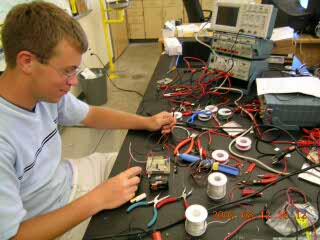13 August, 2003
Jason's Thermometer
In preparation for the trip, one of my students from last year, Jason
Hunter, has been constructing a thermometer to put aboard one of the
first few balloons that will be launched in August.
Jason works during the day so we meet in the evenings in my classroom
at school. He has worked four nights trying to get the electronic
thermometer to work. We are using a specialty chip designed to go to
-55 °C. We expect temperatures in the polar stratosphere to drop even
colder than that so we are curious if this chip will give reliable
results at colder temperatures. The chip produces a voltage that is
converted into a frequency and then those pulses are counted by an
on-board computer. This frequency will be relayed back by radio to
the ground station at McMurdo. This is how all the data is sent,
including the actual thermometer that is used. It will be interesting
to see how well Jason's thermometer will match the data from the one
on-board the balloon.
Tonight we finally have had success! A quick trip to Baskin's and
Robins and we have some dry ice to test the thermometer. Jason says
CO2 becomes solid at negative 78 degrees C. Through some trickery
with the batteries we are able to read negative temperatures. Now all
we have to do is package the device.
Jason is curious if the battery will change its voltage as it gets
cold. This is a common problem in electronic circuits and engineers
spend a lot of time making sure circuits work at different
temperatures. To test this, Jason has built another board that will
dangle a battery out in the air and record the voltage. Most of the
electronics carried by the balloon is insulated with Styrofoam and a
tin can of water keeps the batteries warm for the duration of the
flight.
Well, hope it all works!

Jason working on thermometer.

Testing the thermometer.

Close-up of the electronics.
Contact the TEA in the field at
.
If you cannot connect through your browser, copy the
TEA's e-mail address in the "To:" line of
your favorite e-mail package.
|
